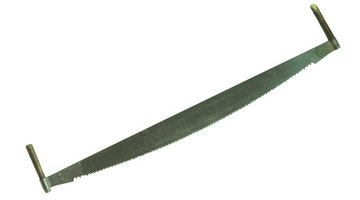How do I Restore a Crosscut Saw?
Before gas- and electric-powered chain saws and table saws, the woodworker relied on the crosscut saw for all of his cutting needs. These long-bladed saws included large wooden handles for control, and they could be used by one or two cutters to saw through thick trees and other such obstacles. Many crosscut saws are now considered antiques, and some may have decades of rust piled on top of the once-sharp metal. Cleaning and sharpening an old crosscut saw can restore its former good looks, and possibly a sharp and useful cutting edge as well.
Cleaning

-
Remove the handle from your crosscut saw. Most handles are held in place with screws, so remove them with a screwdriver or drill. Dispose of any stripped or damaged screws and replace them later.
-
Clamp the saw blade carefully to a flat work surface, with the teeth of the saw facing away from you.
-
Attach a fine cup brush attachment to an electric drill. Run the brush lightly over the saw blade's surface, removing rust, dirt and other buildup. Clean both sides of the saw with the brush to remove as much of the contaminants as possible.
-
Wipe away loose rust and contaminants with a tack cloth. Inspect the surface. Sand any scratched areas or stubborn stains with fine-grit sandpaper. Wipe teh surface with the tack cloth once all stains have been removed.
-
Apply kerosene or a similar oil product to the entire blade with a soft cloth or rag. This lubricates the saw for more effective cutting and rust prevention. Reinstall the handle.
Sharpening
-
Lay a flat piece of 1/4-inch steel on your workbench. Hold the saw, teeth down, over the metal and rock it lightly to observe the cutting teeth. File down any teeth that are too long, using a metal file, so they match the other cutters and even out the cutting surface.
-
Clamp the crosscut saw to your work surface with the blade facing up. Choose a metal file to sharpen your saw that allows you to see the edge of the teeth while filing.
-
File the teeth of the crosscut saw at a 60-degree angle on both sides of the saw to sharpen it. File all teeth to an even sharpness.
References
Tips
- Every crosscut saw includes cutting teeth interspersed with smaller raking teeth. The rakers should be 1/64 inch to 1/12 inch shorter than the cutters.
- Consult experts at hardware and home improvement stores or saw retailers for advice about restoring and sharpening an old crosscut saw.
Warnings
- Avoid coarse brushes or large abrasive cleaning implements, as these can scratch or mar the blade's surface.
Writer Bio
Samantha Volz has been involved in journalistic and informative writing for over eight years. She holds a bachelor's degree in English literature from Lycoming College, Williamsport, Pennsylvania, with a minor in European history. In college she was editor-in-chief of the student newspaper and completed a professional internship with the "Williamsport Sun-Gazette," serving as a full-time reporter. She resides in Horsham, Pennsylvania.
Photo Credits
- hand saw image by drx from Fotolia.com
More Articles



